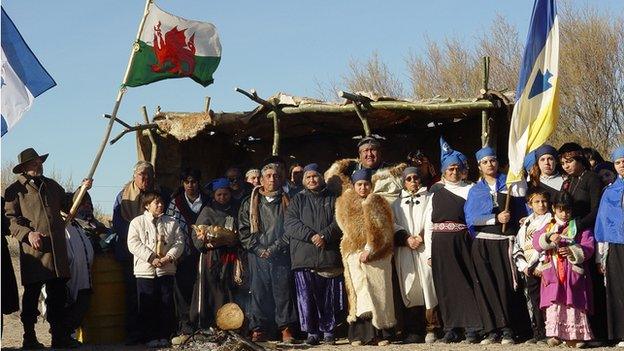150th anniversary of Welsh emigration to Patagonia
- Published

There are annual events to mark the anniversary
The 150th anniversary of the migration of Welsh settlers to Patagonia is being marked with events in Argentina and Wales.
First Minister Carwyn Jones has travelled to South America to attend celebrations in Patagonia.
The first wave of settlers sailed on the converted tea clipper Mimosa from Liverpool to Puerto Madryn in 1865, arriving on 28 July after a two-month journey that cost £12 per head.
Led by Rev Michael D Jones they had set out to create a new colony where they could preserve their culture, language, and Protestant nonconformist religion, free from English influence.
Jones - a radical nonconformist minister - chose a remote location because he believed that Welsh people who emigrated to English-speaking parts of the world, like the US, were too easily assimilated and lost their customs, language and religion.
The first migrants expected a fertile promised land, but arrived to find a desolate, windswept semi-desert with little shelter or food. After many difficult years battling drought, flash floods, hunger, crop failures and bureaucracy they eventually irrigated the land and established several towns near the Atlantic coast - 800 miles (1,300km) south of Buenos Aires - and 400 miles west at the foot of the Andes.

The landing of the immigrants is re-enacted
Announcing his visit earlier this year, Carwyn Jones said: "As a nation, we are very proud of the strong links that we share with the settlements in Patagonia."
Celebrations in Argentina are centred around the annual Gŵyl y Glaniad (Festival of Landing) in Puerto Madryn on 28 July, which includes a re-enactment of the 153 settlers disembarking the Mimosa via a small boat.
The event also includes a ceremonial exchange of gifts between the Welsh and the indigenous Tehuelche communities. The Welsh colonists befriended the local Tehuelche people, who are credited with helping the settlers survive the early years by passing on skills like hunting, and bartering meat for Welsh bread.
The Welsh hymn Calon Lân will be sung in Welsh and Spanish, followed by both national anthems, and flowers will be laid on the grave of another settlement leader Lewis Jones, after whom the town of Trelew is named.
In the afternoon, a traditional tea is being served in local Welsh chapels.
In the Andes region, a ceremony is being held at a monument to the Mimosa in Trevelin, followed by the unveiling of a sign declaring the town to be twinned with Cardigan in Ceredigion.
Events such as concerts, shows and banquets will be held in the town, and the neighbouring Welsh-founded community of Esquel, throughout the week.

Welsh people were helped by native American locals, a partnership which is still celebrated
A competition will be held in Trelew for the best 'black cake', or cacen ddu - a fusion of the traditional Welsh bara brith and Christmas cake. Black cake has become a symbol of Welsh Patagonia after the early settlers created it to help sustain them during floods or food shortages.
In Wales, exhibitions dedicated to the pioneers are being held at Bangor University and the National Library of Wales, in Aberystwyth.
The National Youth Choir of Wales launched its Patagonia 150 celebrations last week with concerts in Cardiff Bay and Llandaff Cathedral.
The choir - which has been working on a Latin American repertoire with Buenos Aires composer Camilo Santostefano, as well as studying Welsh music with John S Davies - will be touring Argentina in October.
Clwyd Theatr Cymru began performing a specially created production called Mimosa, telling the story of the settlers quest, in May and June. This month a company of young Welsh and Argentina performers joined the team to tour in both Wales and Patagonia.
Paula Dear in Patagonia
There will be a special annual dinner of the Wales-Argentina Society in Caernarfon, and celebrations in Aberystwyth, which is twinned with Esquel.
In November, comedian Rhod Gilbert and Manic Street Preachers members James Dean Bradfield and Sean Moore are taking part in a six-day charity hike to mark the anniversary by following on the footsteps of the Welsh pioneers. They will be part of a group trek that includes a climb up Craig Goch, from where the settlers saw Cwm Hyfryd (the valley) for the first time.
The event, plus a second trek being led by former Welsh rugby international player Shane Williams, will raise funds for Cardiff's Velindre Cancer Centre.
In the same month there will also be a special annual eisteddfod in Trelew, Argentina.
The anniversary of Mimosa's departure from Liverpool was marked in May with the unveiling of a red dragon monument at the city's Princess Dock.

Sailing into the unknown
May 1865 - 153 Welsh settlers sailed on the Mimosa from Liverpool to Argentina, paying £12 per ticket. Arrived 28 July at New Bay (Puerto Madryn).
Five children died, two babies were born, and one couple got married during the journey.
The Argentine government - which wanted to populate Patagonia - offered settlers land.
Arrived to find inhospitable semi-desert with no shelter and very little food. Flash floods and crop failures dominated early years.
Befriended local Tehuelche natives - with their help and the perseverance of settlers, colony flourished and expanded.
Government assimilation policies, immigrant arrivals from other countries, internal disunity and a decline in new Welsh settlers from around WWI, caused stagnation by 1930s.
Centenary celebrations in 1965 began increased contact with Wales and seeded a revival of language and culture. Launch of bilingual eisteddfod opened Welsh culture to all.

- Published27 July 2015
